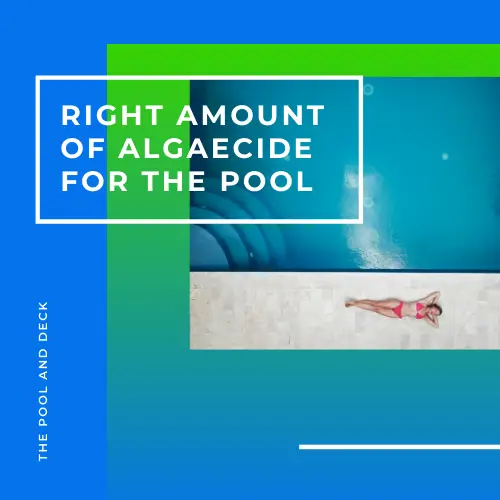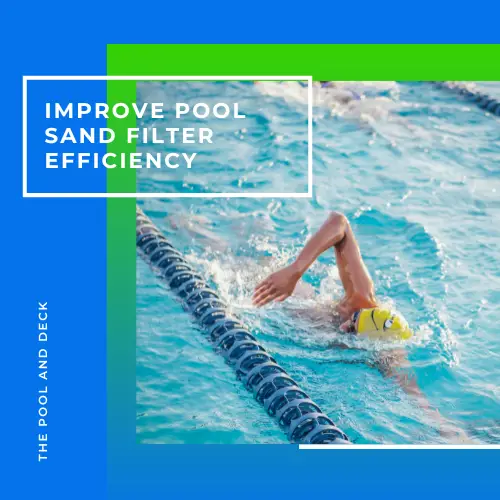Pool Chlorine Too High? 7 Effective Ways To Lower It!
As an Amazon Associate, I earn from qualifying purchases.
Does your skin burn and do your eyes get red after a swim? Pool chlorine too high is the most likely cause.
You certainly don’t want the “pool chlorine too high” situation to persist as it can lead to a number of problems such as skin & eye irritation and corrosion of metallic pool equipment.

In this article I explain the importance of chlorine as a pool sanitizer as well as what to do if you find that pool chlorine is too high.
Table of Contents
Importance of Chlorine for Pool Sanitization
Chlorine is, arguably, the most important pool chemical. Its role is to keep the water disinfected and sanitized. It does this by killing the pathogens that can cause diseases.
Chlorine reacts with the pool water to form a weak acid called Hypochlorous Acid (HOCL) which sanitizes & disinfects by killing the viruses, germs, bacteria & algae.
The acid penetrates the cell walls of the pathogens and makes the cell’s protein backbone dysfunctional.
What is the Ideal Pool Chlorine Level?
The ideal pool chlorine level is 2 – 4 ppm. In case the pool chlorine level exceeds 5 ppm then it is considered high. Pool chlorine is too high when the chlorine level exceeds 7 – 8 ppm.
Pool chlorine levels of 2 – 4 ppm are high enough to kill pathogens such as bacteria and algae and yet low enough for swimmer comfort.
When the chlorine level is higher than 5 ppm swimmers may start to get red eyes, itching skin and stiff hair after a swim.
Swimming should not be permitted in the pool if the free chlorine level exceeds 7 – 8 ppm as it could be hazardous to swimmers health.
Chlorine levels need to be brought down below 5 ppm, before the pool can be reopened for swimming.
For more information, read Pool Chemistry for Beginners: With 5 Super Helpful Cheat Sheets!
What Makes Pool Chlorine Too High?
Generally speaking, over-chlorination or reduced pool usage is what can make pool chlorine too high.
Chances are that if these are pre-planned then chlorine levels spike up for a short period of time. However, if it happens because of a miscalculation then you could have the problem of high pool chlorine levels for an extended period.
What Makes Pool Chlorine Too High Temporarily?
1. Shock Treatment: The most common, and certainly a pre-planned reason for a spike in pool chlorine levels is shocking the pool.
Shock is added to the pool as and when required or on a weekly basis. Shock is typically used to address specific issues such as algae growth, cloudy water, or an unpleasant odor from chloramine build up.
Recommended Cyanuric Acid Free Shock (Cal Hypo)
HTH 52037 Pool Care Shock Advanced
A fast-dissolving, convenient 4-in-1 Cal Hypo formula that kills bacteria & algae, reduces chlorine odor & irritation, and quickly restores crystal clarity.
The best time to add shock is in the evening as the pool can not be used for several hours after that. The free chlorine spikes to a level (typically in the 20 – 30 ppm range) that is unsafe for swimming.
You should only swim after testing the pool water and ensuring that the chlorine levels are in the 2-4 ppm range.
2. Equipment Malfunction: Malfunctioning pool equipment such as chlorine feeders or automatic chlorinators can release too much chlorine into the water at once, causing a temporary increase in chlorine levels.
3. Cold & Cloudy Weather: Chlorine dissipation slows down in cold and cloudy weather. Pathogen activity slows down, reducing chlorine demand. Moreover, reduced sunlight slows down the UV degradation.
If the dosage is not reduced to account for these factors then chlorine level may go up temporarily.
What Makes Pool Chlorine Too High for an Extended Period?
1. Irregular Testing: A very common scenario is that pool owners chlorinate their pools with Trichlor tablets. Trichlor tablets are typically placed in floaters, the pool’s skimmer or a dedicated chlorine feeder.
If there is a miscalculation on the number of Trichlor tablets required and the pool water chlorine levels are not being tested regularly then it could make pool chlorine too high for extended periods.
2. Stabilizer Build-Up: Cyanuric acid, commonly used as a chlorine stabilizer, can accumulate in pool water over time. Excessive stabilizer levels can reduce chlorine’s effectiveness, leading to persistently high chlorine levels.
3. Chlorine Tablet Overuse: Over-reliance on chlorine tablets without considering pool size and usage can lead to a continuous release of chlorine, causing levels to remain high for an extended period.
4. Reduced Pool Usage: Low pool usage means less demand for chlorine. If chlorine continues to be added at the same rate without considering reduced usage, it will make pool chlorine too high over time.
How to Lower Pool Chlorine Levels
If you think that the pool chlorine is too high, the first step is to test so that you know what chlorine level actually is. There are three options available for testing pool water chemistry.
- Test Strips
- Chemical Test Kits
- Electronic Test Kits
Recommended Electronic Test Kit
Comprehensive 27-parameter water testing for pools and hot tubs, ensuring crystal clear, safe, and perfectly balanced water.
Once you know how high the pool chlorine level is, you can take one or more of the actions recommended below:
1. Cease Chlorine Addition:
- Turn off chlorinators and remove chlorine sources like tablets or floaters.
- By halting chlorine input, the existing chlorine can gradually dissipate.
2. Harness Sunlight:
- Expose your pool to sunlight to aid in chlorine breakdown.
- UV rays naturally degrade chlorine levels, assisting in reduction over time.
3. Use Chlorine Neutralizers:
- Employ chlorine-neutralizing products according to instructions.
- These products effectively reduce chlorine levels without disrupting water balance.
4. Increase Pool Use:
- Encourage more swimming activity to consume excess chlorine.
- Regular use helps balance chlorine levels naturally over time.
5. Partial Drainage and Refill:
- If necessary, partially drain the pool and refill with fresh water.
- Be cautious when adjusting chemical balance post-refill.
6. Sodium Thiosulfate Treatment:
- Consider using sodium thiosulfate to neutralize chlorine.
- Monitor pH levels and chlorine concentration post-treatment for balance.
7. Pool-Grade Hydrogen Peroxide:
- Explore pool-grade hydrogen peroxide for chlorine reduction.
- Monitor and adjust pH levels accordingly after treatment.
Each method’s efficacy varies based on chlorine concentration and pool conditions. Select the most suitable method considering your pool’s specifics.
A combination, such as ceasing chlorine addition, exposure to sunlight and increased pool usage will typically bring quick results.
Thank you very much for reading the post. I do hope you found it informative and helpful.








